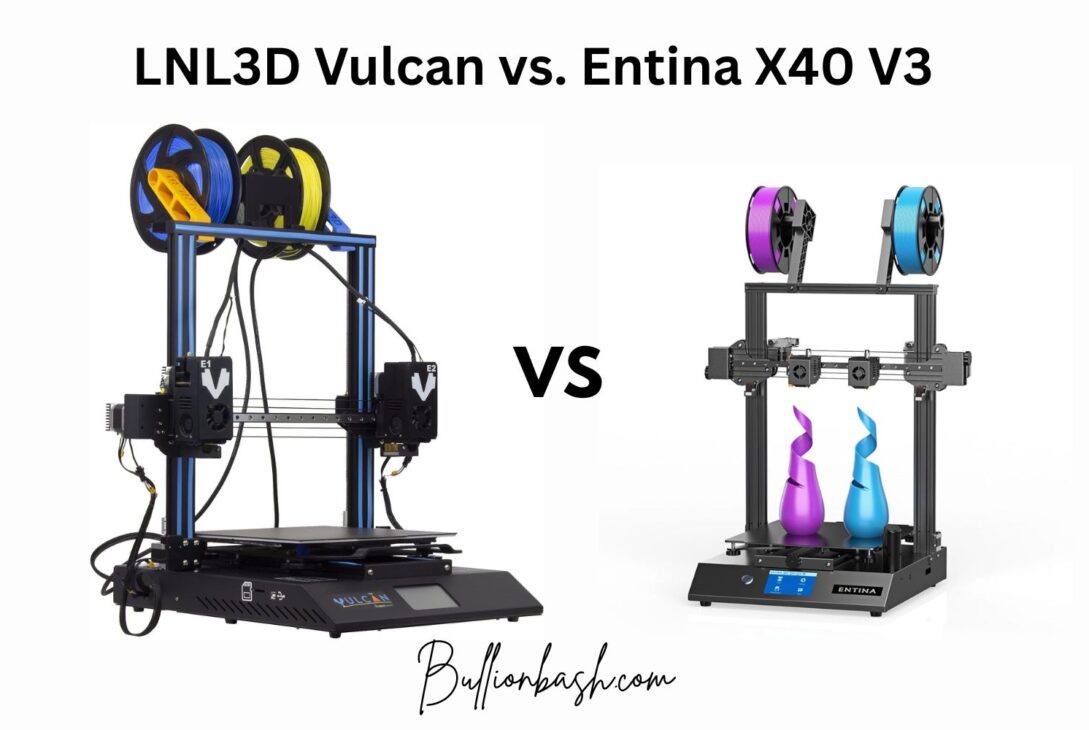Introduction
If you’re stuck deciding between the LNL3D Vulcan vs. Entina X40 V3, here’s the quick answer: the Vulcan is built for users who want professional-grade prints with higher durability, while the Entina X40 V3 is a flexible, budget-friendly machine aimed at hobbyists and beginners. But the choice really depends on what you’re printing, how often, and how much you want to spend. Let’s break it down in detail.
Quick Overview of Both 3D Printers
The LNL3D Vulcan is known for its solid build volume, advanced stability, and professional-quality results. It’s often marketed toward small businesses, prototyping labs, and serious makers who need consistent performance.
The Entina X40 V3, on the other hand, is designed as a versatile and affordable 3D printer for everyday users. It balances decent print quality with a more accessible price point, making it a go-to for hobbyists, students, and schools exploring 3D printing.
Core Specifications Side-by-Side
| Feature | LNL3D Vulcan | Entina X40 V3 |
| Build Volume | 300 x 300 x 400 mm | 235 x 235 x 250 mm |
| Print Speed | Up to 200 mm/s | Up to 150 mm/s |
| Layer Resolution | 50–200 microns | 100–200 microns |
| Supported Materials | PLA, ABS, PETG, TPU | PLA, ABS, PETG |
| Connectivity | Wi-Fi, USB, SD card | USB, Wi-Fi optional |
| Software | Cura, Simplify3D, PrusaSlicer | Cura, Creality Slicer |
This table shows why the Vulcan appeals to professionals: a bigger build area, faster speeds, and better layer resolution. Meanwhile, the X40 V3 focuses on simplicity and reliability at a lower cost.
Print Quality & Performance in Real-World Use
When it comes to print quality, the Vulcan produces finer layers with less visible banding, which is crucial for models that require detailed finishing. Its stability system helps reduce wobble even during taller prints.
The Entina X40 V3 offers respectable results, especially with PLA and PETG, but struggles slightly with flexible materials like TPU. For hobby-level projects, it’s more than enough. However, if you’re printing engineering parts or functional prototypes, the Vulcan clearly wins.
Users also report the Vulcan handles long, overnight prints more reliably, while the X40 V3 sometimes requires recalibration after extended use.
Ease of Use & Setup Experience
The Entina X40 V3 shines for beginners. Its semi-assembled kit allows users to get started quickly, and the touchscreen interface is easy to navigate. Many owners say they were printing within an hour.
The Vulcan, being a more advanced system, has a slightly steeper setup process. Its manual calibration requires more attention, but once set up properly, it delivers a far more stable experience. For pros, this tradeoff is worth it.
Pros and Cons Comparison
| Printer | Pros | Cons |
| LNL3D Vulcan | Larger build volume, faster speeds, higher resolution, professional-grade results | Higher price, steeper learning curve |
| Entina X40 V3 | Affordable, beginner-friendly, easy setup, compact size | Smaller build area, less reliable for long prints, limited material compatibility |
Who should choose which?
- Pick the Vulcan if you need precision prototypes, engineering parts, or large models.
- Pick the X40 V3 if you want a budget-friendly starter printer for casual projects.
Pricing & Value for Money
The Vulcan sits in the mid-to-high range of consumer 3D printers. It’s not the cheapest, but the extra investment pays off if you need durability and speed. The Entina X40 V3, meanwhile, is among the most affordable in its class — often priced lower than many entry-level competitors while still offering Wi-Fi support and Cura compatibility.
When considering long-term value, factor in material costs, maintenance, and potential upgrades. The Vulcan will demand a higher upfront cost but may save money over time due to its reliability.
Decision Factors — Which One Should You Buy?
Best for Beginners
The Entina X40 V3 wins here because of its ease of setup and low price point. Students, hobbyists, and classrooms will find it friendly and reliable enough for learning.
Best for Professionals
The LNL3D Vulcan is the clear choice for serious makers and small businesses. If you need faster speeds, higher resolution, and a larger build volume, it’s worth the price difference.
Best for Educational Use
Schools may lean toward the X40 V3 since it’s cost-effective, easier to maintain, and simple for teachers to set up.
Common Mistakes When Choosing Between the Two
- Only looking at price and ignoring build volume.
- Forgetting about material compatibility (TPU, ABS, PETG).
- Not considering print speed when planning multiple projects.
- Overlooking the importance of long-term durability.
- Ignoring software compatibility when switching from other printers.
Final Verdict — LNL3D Vulcan or Entina X40 V3?
Both printers serve different audiences. If you’re a hobbyist or student, the Entina X40 V3 is a great, affordable entry point. If you’re a professional maker or a small business, the LNL3D Vulcan gives you the durability, precision, and larger build capacity that justify the cost.
In short: if print quality and reliability matter most, go with the Vulcan. If you just want to get started and spend less, the X40 V3 is more than enough. And that’s the real takeaway from comparing the LNL3D Vulcan vs. Entina X40 V3.
FAQs — Answering Buyer Questions
1. Is the Vulcan better for beginners than the X40 V3?
Not really — the Vulcan is aimed at pros, while the X40 V3 is simpler for first-timers.
2. Which has faster print speeds?
The Vulcan, with up to 200 mm/s, compared to 150 mm/s on the X40 V3.
3. Can both printers handle TPU?
The Vulcan handles it better; the X40 V3 struggles with flexible filaments.
4. Which is quieter?
The Vulcan is slightly quieter during longer prints, though both are relatively noisy compared to enclosed printers.
5. Which offers better long-term durability?
The Vulcan is built to last longer with less recalibration needed.
6. Are they both compatible with Cura?
Yes, both support Cura, but the Vulcan also works smoothly with Simplify3D and PrusaSlicer.
7. Which is better for schools?
The X40 V3 is more budget-friendly and beginner-focused, making it great for classrooms.
8. Does the Vulcan justify its higher price?
Yes — if you’re running professional or business-level projects, the investment is worth it.
Conclusion
Choosing between these two printers really comes down to your needs. The Vulcan is built for serious makers and professionals who value speed, resolution, and durability. The Entina X40 V3 is a cost-effective, friendly choice for hobbyists and classrooms. Whichever you pick, you’ll be stepping into a world of creative possibilities — and now you know the key differences between the LNL3D Vulcan vs. Entina X40 V3.
Read More: Mary Jennet Swaisy Rockwood: DIY Tips That Really Work


